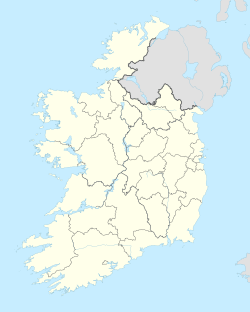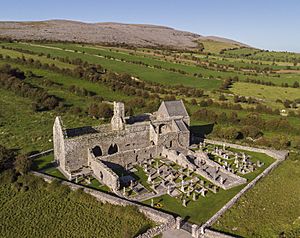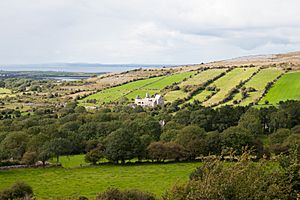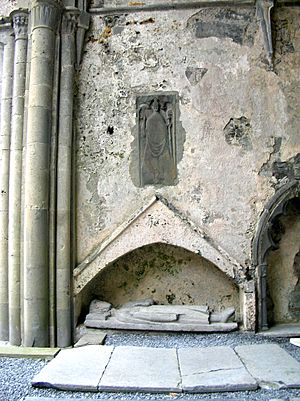Corcomroe Abbey facts for kids
| Mainistir Chorco Modhruadh | |

Corcomroe Abbey as viewed from the southeast
|
|
| Monastery information | |
|---|---|
| Order | Cistercians |
| Established | 1180–1200 |
| Disestablished | 1554 |
| Diocese | Galway, Kilmacduagh and Kilfenora |
| People | |
| Founder(s) | Domnall Mór Ua Briain or Donough Cairbreach |
| Architecture | |
| Status | Inactive |
| Style | Romanesque |
| Site | |
| Location | County Clare, Ireland |
| Coordinates | 53°07′36″N 9°03′14″W / 53.126703°N 9.054014°W |
| Public access | Yes |
| Official name | Corcomroe Abbey |
| Reference no. | 11 |
Corcomroe Abbey (in Irish: Mainistir Chorca Mrua) is an old Cistercian monastery from the early 13th century. It's found in the northern part of the Burren region in County Clare, Ireland. People once called it "St. Mary of the Fertile Rock" because of the rich soil in the Burren.
The abbey's Romanesque ruins are famous for their amazing stone carvings. These carvings are some of the best you can find in a Cistercian church in Ireland. The abbey even appears in W.B. Yeats' play The Dreaming of Bones. Today, Corcomroe Abbey is a National Monument and visitors can explore it.
Contents
Where is Corcomroe Abbey?
The ruins of Corcomroe Abbey are in a valley called Glennamannagh, part of the Burren. It's about 800 meters east of Bellharbour village. The bigger village of Ballyvaughan is a few miles to the west. A road called the L1014 passes very close to the abbey. Even though there isn't a river right at the site, there are several wells nearby. These wells likely provided water for the monks who lived there.
A Look at History
How the Abbey Started
Around the late 1100s, a group of Cistercian monks came to this area. They came from an abbey called Inislounaght in County Tipperary. Historians aren't completely sure when the abbey was built, but it was sometime between 1180 and 1200.
Two kings are often given credit for starting the abbey: Donal Mór Ua Briain, who died in 1194, or his successor, Donough Cairbreach. Donal Mór Ua Briain helped build many other religious places in the Thomond region. If Corcomroe Abbey started a smaller abbey in 1198, then Donal Mór Ua Briain is probably the founder. Based on the building's style, many think it was built around 1205–1210.
The abbey was built using local limestone. There's a famous legend that says King Conor na Siudane Ua Briain ordered the building. The story goes that after the five masons finished the abbey, the king had them killed. He didn't want them to build another beautiful masterpiece anywhere else!
Life at the Abbey
We don't have many written records about Corcomroe Abbey. Unlike some other groups, Cistercian monks didn't work much with local people. This means not many stories or traditions about the abbey were passed down.
In 1226, a letter from the Pope showed that Corcomroe Abbey was part of the larger Cistercian network. The abbot (the head monk) was an important person in the local church. In 1228, Corcomroe Abbey stopped being connected to its original "mother-house" at Inislounaght. Instead, it became linked to Furness Abbey. This was part of a plan to keep better control over the more distant abbeys in Ireland.
Battles and Changes
A report from the 15th century says that in 1268, a battle happened near Corcomroe. King Conor O'Brien (also known as Conor na Siudane Ua Briain) was surprised by an enemy and killed. His body was brought to Corcomroe by the monks and buried there.
Another battle happened nearby in 1317. This was during a time when different groups of the O'Brien family were fighting each other. The abbey was even used as a place for soldiers to stay by Dermot O'Brien.
By the end of the 1300s, a family called the O'Cahans controlled the land around the abbey. It's not clear exactly how this happened. The wool trade, which had been very good, started to decline. The abbey might have sold or borrowed money against its land to help its finances. The O'Cahans then became managers of the abbey's lands.
Decline and Dissolution
In the 1400s, there were problems with how abbots were chosen. Sometimes, family members would take over the abbey, and they would use the abbey's money for themselves. This led to a decline in the monasteries. The number of monks went down, and churches became smaller. At Corcomroe, the church was made 13 meters shorter in the 15th century. It also seems that the monks' sleeping area was no longer being used.
The English Reformation was a time when the Catholic monasteries in England and Ireland were closed down. In 1554, Corcomroe Abbey and its land were given to Murrough O'Brien, who was the Earl of Thomond. The land was last mentioned in his family's papers in 1702.
Even after this, the monks tried to keep the fields and the abbey going. But the political situation made things harder, and the abbey continued to decline. In 1879, the Office of Public Works took over the ruins to protect them.
What Corcomroe Abbey Looks Like
Corcomroe Abbey was built following the usual plan for Cistercian monasteries, but on a smaller scale. The church is shaped like a cross (called a cruciform church) and faces east. It has only one small chapel on each side and a small courtyard for the monks.
The church no longer has a roof, but most of its walls are still standing. Only a few parts of the monks' living areas remain. However, large sections of the high wall that surrounded the abbey's five-acre area can still be seen. The arched gate in this wall was blown down by a storm in 1839. Its remains are about 100 meters west of the church.
The abbey is famous for its very detailed carvings and rich decorations. These kinds of decorations are not often found in buildings from this time period.
Special Carvings and Tombs

You can see detailed columns, capitals (the tops of columns), and ribs that support the vaulted ceiling of the sanctuary (or choir). The sanctuary also holds the tomb of King Conor O'Brien (Conor na Siudane Ua Briain). His tomb is in an arched space. The effigy (a statue of a person) is made of limestone and is almost life-size. It's one of the few statues from that time that shows an Irish chieftain. Even though it was damaged in the early 1800s, the monument is still in good condition.

Another tomb, added later, is the "O'Loughlin King of the Burren Family Tomb." It's from the late 1700s or early 1800s and is on the floor in front of King Conor O'Brien's tomb.
Visiting Today
Today, Corcomroe Abbey is a popular place for tourists to visit. It is open to the public, allowing people to explore its ancient ruins and learn about its history.
Images for kids
See also
 In Spanish: Abadía de Corcomroe para niños
In Spanish: Abadía de Corcomroe para niños











